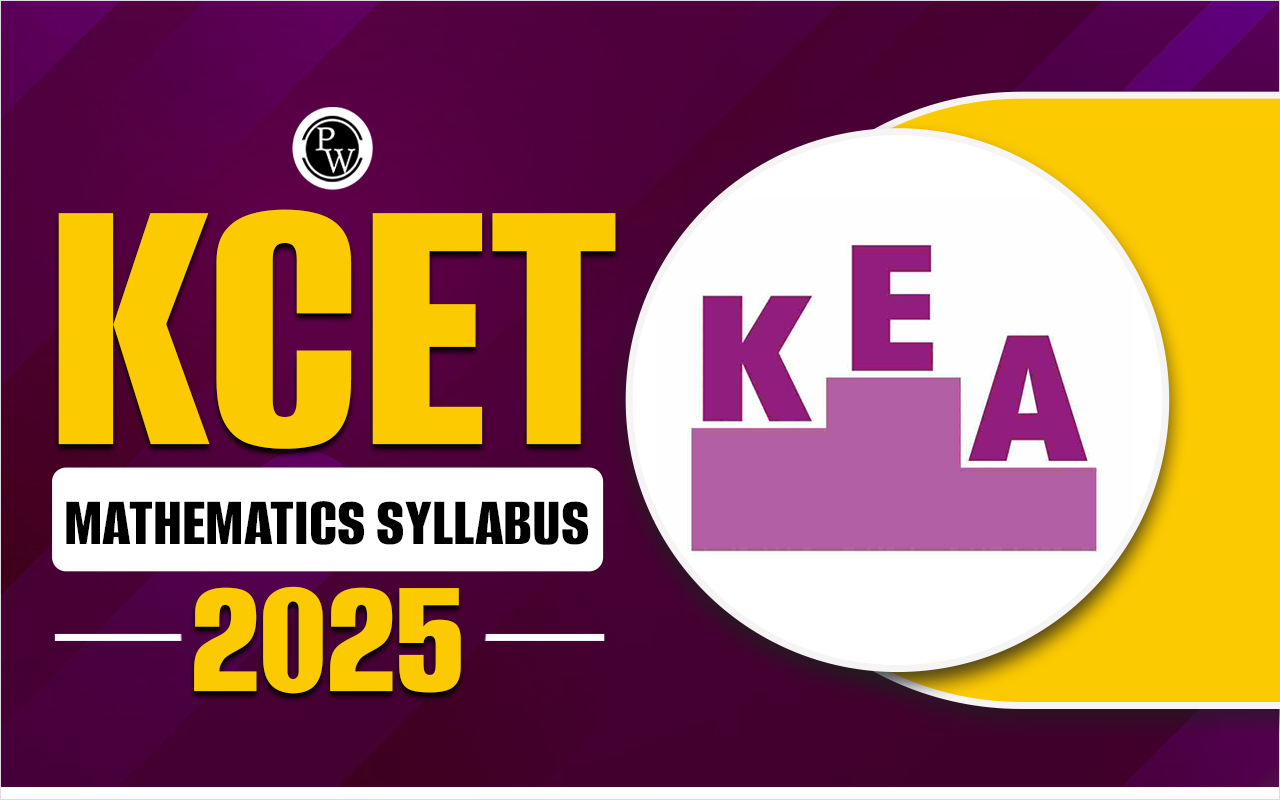

KCET Physics Notes for Class 11 and 12 provide a comprehensive overview aligned with the KCET 2025 exam pattern and syllabus prescribed by the Karnataka Pre-University Education Board. These notes cover key concepts, formulas, and derivations from both years, helping students strengthen their understanding and boost accuracy.
A strong focus is placed on solving previous year papers, which helps in understanding question trends and improving time management. These notes are structured to build conceptual clarity and application skills, both of which are essential for scoring high in KCET Physics. Regular revision and practice are key to mastering the subject.
KCET Rank Wise College List 2025
KCET Physics Notes Class 11 and 12
Below, we have provided KCET Physics Notes for Classes 11 and 12, based on the latest syllabus and KCET Exam Pattern. These notes are designed to simplify complex concepts and aid in quick revision. They also include key highlights from previous year papers to help students focus on important topics and prepare effectively for the KCET exam.
|
KCET Physics Notes Class 11 and 12 |
|
|
Topic Name |
PDF Link |
|
Work Energy and Power |
|
|
Units and Dimension |
|
|
Moving Charges and Magnetism |
|
|
Motion in One Dimension |
|
|
Motion in a Plane |
|
|
Laws of Motion |
|
|
Current Electricity |
|
|
Circular Motion |
|
|
Waves |
|
|
Wave Optics |
|
|
Thermodynamics |
|
|
Thermal Properties |
|
|
Ray Optics |
|
|
Oscillations |
|
|
Mechanical Properties of Solids |
|
|
Mechanical Properties of Fluids |
|
|
Magnetism and Matter |
|
|
Kinetic Theory of Gases |
|
|
Gravitation |
|
|
Electrostatic Potential and Capacitance |
|
|
Electromagnetic Waves |
|
|
Electromagnetic Induction |
|
|
Electric Charges and Fields |
|
|
Dual Nature of Matter |
|
|
Atoms and Nuclei |
|
|
Alternating Current |
|
Check: KCET Career Options 2025
Detailed Overview of KCET Physics Notes class 11 and 12
Here is an overview of the KCET Physics Notes for each chapter. This is structured to help students with KCET Syllabus coverage, conceptual clarity, and exam readiness:
1. Work, Energy and Power
This chapter explains the concepts of work done by a force, kinetic and potential energy, and the work-energy theorem. The notes cover derivations and problem-solving strategies important for MCQs.
2. Units and Dimensions
Covers fundamental and derived units, dimensional analysis, and error estimation. KCET often includes direct formula-based questions from this chapter.
3. Moving Charges and Magnetism
Includes Biot–Savart law, Ampere’s circuital law, and magnetic force on moving charges. Notes focus on diagram-based understanding and the application of formulas.
4. Motion in One Dimension
Focuses on kinematics, equations of motion, and graphical representation. Helpful for building strong fundamentals in Physics.
5. Motion in a Plane
Introduces vectors, projectile motion, and relative velocity. Notes include vector resolution techniques commonly used in numericals.
6. Laws of Motion
Explains Newton’s laws, friction, and dynamics of circular motion. KCET often tests conceptual clarity from this chapter.
7. Current Electricity
Includes Ohm’s law, series-parallel circuits, and Kirchhoff’s rules. Notes emphasize circuit-based questions and practice with numerical problems.
8. Circular Motion
Focuses on uniform circular motion, centripetal force, and applications. Useful in both theoretical and numerical KCET questions.
9. Waves
Covers types of waves, principle of superposition, and resonance. Important derivations and graphs are simplified for revision.
10. Wave Optics
Focuses on interference, diffraction, and polarization. KCET asks theory-based as well as numerical questions from this section.
11. Thermodynamics
Includes laws of thermodynamics, heat engines, and specific heat. Notes include key formulas and process-based diagrams.
12. Thermal Properties of Matter
Covers expansion of solids/liquids, calorimetry, and heat transfer methods. Formula sheet and solved examples are included in the notes.
13. Ray Optics
Explains reflection, refraction, and lens/mirror formulas. Diagrams and ray-tracing are emphasized for clear understanding.
14. Oscillations
Focuses on simple harmonic motion, damped and forced oscillations. Notes include graphs and formula tricks for problem-solving.
15. Mechanical Properties of Solids
Includes stress, strain, modulus of elasticity, and Hooke’s law. Important definitions and graphs are well-explained.
16. Mechanical Properties of Fluids
Explains pressure, viscosity, and Bernoulli’s theorem. Notes simplify fluid mechanics problems for quick application.
17. Magnetism and Matter
Covers magnetic properties of materials, Earth’s magnetism, and magnetic field lines. Focus is on conceptual understanding.
18. Kinetic Theory of Gases
Explains molecular theory, ideal gas laws, and degrees of freedom. Notes simplify derivations with stepwise explanation.
19. Gravitation
Includes universal law of gravitation, satellite motion, and escape speed. Diagrams and key equations are covered in detail.
20. Electrostatic Potential and Capacitance
Focuses on electric potential, potential energy, and capacitors. Notes cover numerical tricks and previous year question types.
21. Electromagnetic Waves
Introduces the spectrum, properties of EM waves, and uses. KCET may ask theoretical or direct questions from this chapter.
22. Electromagnetic Induction
Includes Faraday’s laws, Lenz’s law, and induced EMF. Important graphs and formula applications are covered for KCET.
23. Electric Charges and Fields
Covers Coulomb’s law, electric field, and dipole. Notes emphasize vector handling and common MCQ mistakes.
24. Dual Nature of Matter
Explains photoelectric effect and de Broglie wavelength. KCET frequently tests definitions and graphs from this chapter.
25. Atoms and Nuclei
Covers atomic models, radioactivity, and nuclear energy. Key formulas, constants, and numericals are included in summary form.
26. Alternating Current
Includes AC circuits, reactance, impedance, and power factor. Notes provide clear phasor diagrams and solved numericals.
Check: How to Calculate KCET Rank with Board Marks 2025
Benefits of Using KCET Physics Notes class 11 and 12
Here are the benefits of using KCET Physics Notes for Class 11 and 12:
1. Aligned with KCET Syllabus
These notes strictly follow the Karnataka Board PU and KCET syllabus, ensuring that students focus only on relevant topics and avoid unnecessary content.
2. Simplified Concept Explanations
Complex theories and principles are explained in a simplified and student-friendly manner, making it easier to understand and retain concepts.
3. Chapter-wise Structured Notes
The content is organized chapter-wise, allowing students to study systematically and revise specific topics with ease.
4. Complete Formula Coverage
All Important Formulas of Physics for KCET Exam from each chapter are compiled clearly, helping in quick recall and application during problem-solving and revision.
5. Inclusion of Previous Year Questions
The notes highlight commonly asked questions from KCET Previous Year Question Papers, helping students understand the exam pattern and important question trends.
6. Visual Support with Diagrams and Graphs
Well-labeled diagrams and graphs enhance conceptual clarity and are especially useful for visual learners.
7. Practice-Focused Content
Includes solved examples, shortcuts, and key tricks to improve speed and accuracy in answering both theory-based and numerical questions.
8. Suitable for Quick Revision
Concise summaries and key points make these notes ideal for fast and efficient revision before the exam.
KCET Physics Notes class 11 and 12 FAQs
Are these notes based on the KCET syllabus?
Are the notes available in the Kannada language?
Can I use these notes for quick revision before exams?
Do the notes cover diagrams and key terms?













